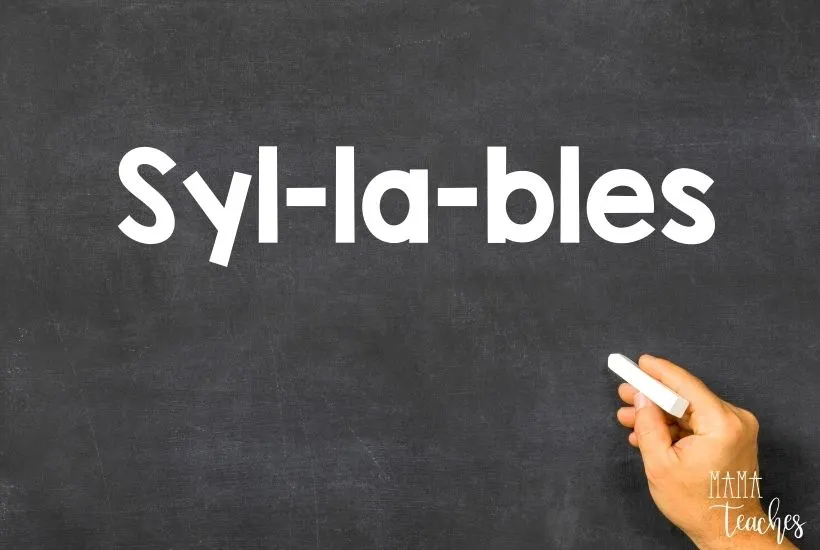Dividing words into syllables is a game-changing decoding strategy.
If you know how to teach syllables, you can take a beginning reader from “fab” to “fabulous” in no time!
Teaching Syllables
As adults, we only think about syllables when we see a dictionary entry or a word at the end of a line that has been broken by a hyphen.
That’s because our brain already automatically does the heavy-lifting of breaking new, long words into syllables so we can read them.
How did we learn how to break words into syllables?
We were taught, of course!
Pass this necessary reading skill on to your students by learning how to teach syllables.

This article contains affiliate links to things that you might like.
What is a Syllable?
A syllable is a group of letters producing a single sound.
It has only one vowel sound, and may or may not be accompanied by other consonant sounds.
A vowel sound is not the same as the number of vowels.
For instance, the word “each” has two vowels in it (e and a), but since those vowels work together to produce a single vowel sound, the word is only one syllable.
A similar example is the word “name.” “Name” has two vowels as well (a and e), but since the e is silent, there is only one vowel sound.
Thus the word is one syllable.
How to Divide Words into Syllables
It is easy to hear the number of syllables in a word if you think of each syllable as a beat in music.
You can clap, stomp, or snap along as you say each syllable in a word.
For example, the word “elephant” receives three claps, since it has three vowel sounds and, thus, three syllables.

Syllable Rules
As with everything in language, there are a host of rules humming along under the surface that we often intuit rather than teach.
Knowing the syllable rules yourself can help you model to your students how to break up a word into syllables, even if you never teach these rules explicitly.
To understand the syllables rules below, you need to know that “V” is for vowel sound and “C” is for consonant sound.
Got it?
OK, here we go!
VC-CV
If you have two consonant sounds (again, sounds, not necessarily individual letters) between two vowel sounds, you divide the word between the consonants.
Here are some examples of this pattern:
- sun-rise
- base-ball
- sim-ple
V-CV
If you have only a single consonant sound between two vowel sounds, you might have a V-CV pattern.
If the first vowel sound is long and open (like “play,” “be,” or “mo”), end the syllable there.
The second syllable picks up the consonant.
You can see this in these words:
- play-bill
- be-fore
- mo-tion
VC-V
The V-CV pattern looks a lot like the one before it, but in this case, the first vowel sound is short and ends with a consonant (like “tim,” “riv,” or “bod”).
The second syllable begins with a vowel sound.
Here are some examples:
- tim-id
- riv-er
- bod-y
V-V
Sometimes we have two vowels side by side in a word, but they each make their own vowel sound.
In these cases, we have two-syllable words.
You can see that in words like:
- re-act
- high-er
- Di-anne
Although it is not necessary to teach young children these syllable rules, they are very helpful for you to know as a teacher.
When you are working one-on-one with a beginning reader and she encounters a multi-syllable word, you can use your finger to cover up the word and reveal it syllable by syllable, enabling her to sound out the parts of the words.
Then she can reread the word in its entirety.

Activities to Teach Syllables
Teaching syllables doesn’t have to be boring.
Make it fun with some of these activities!
Percussive Syllables
Why not merge music and math for some kinesthetic learning?
Chant words and clap, snap, stomp, bang, shake, ring, or rattle along with each syllable.
You do it first and the kids repeat after you.
Compound Word Match
Compound words are a wonderful place to start with multi-syllable words because kids recognize (and can read with confidence) the individual syllables.
Write the syllables on cards and have them slide the words together to read.
You can give clues like a riddle.
(e.g. “I am round and used in a game with a bat.” Answer: base + ball = baseball).
Here are some compound words to try:
- nightlight
- lunchtime
- sunset
- doghouse
- hotdog
Syllable Songs
Clap along with classic songs to attune the child’s ear to hearing syllables.
Some favorites to try include “Jingle Bells,” “Happy Birthday,” and “The Itsy, Bitsy Spider.”

Syllable Sleeping Bag
Make a “sleeping bag” for multi-syllable word cards (you can make your own word cards out of index cards).
This sleeping bag can be as simple as a piece of construction paper folded in half and stapled.
Slide the word card in the sleeping bag.
Pull out the word syllable by syllable for the child to read.
Wikki Stix Division
If you teach the syllable rules to your kids, have them practice dividing the large-font, multi-syllable words with Wikki Stix.
Slide the waxy string just where the word breaks into syllables.
Mirror, Mirror
Sometimes kids have to see syllables to believe them.
Practice saying multi-syllable words in front of a mirror, prolonging each vowel sound so the child can see his mouth move and change with each syllable.
How to Teach Syllables to Kids
Syllables don’t have to be scary; they are empowering!
Once you learn how to break a word into syllables, you can teach a child to read any word, anywhere.
